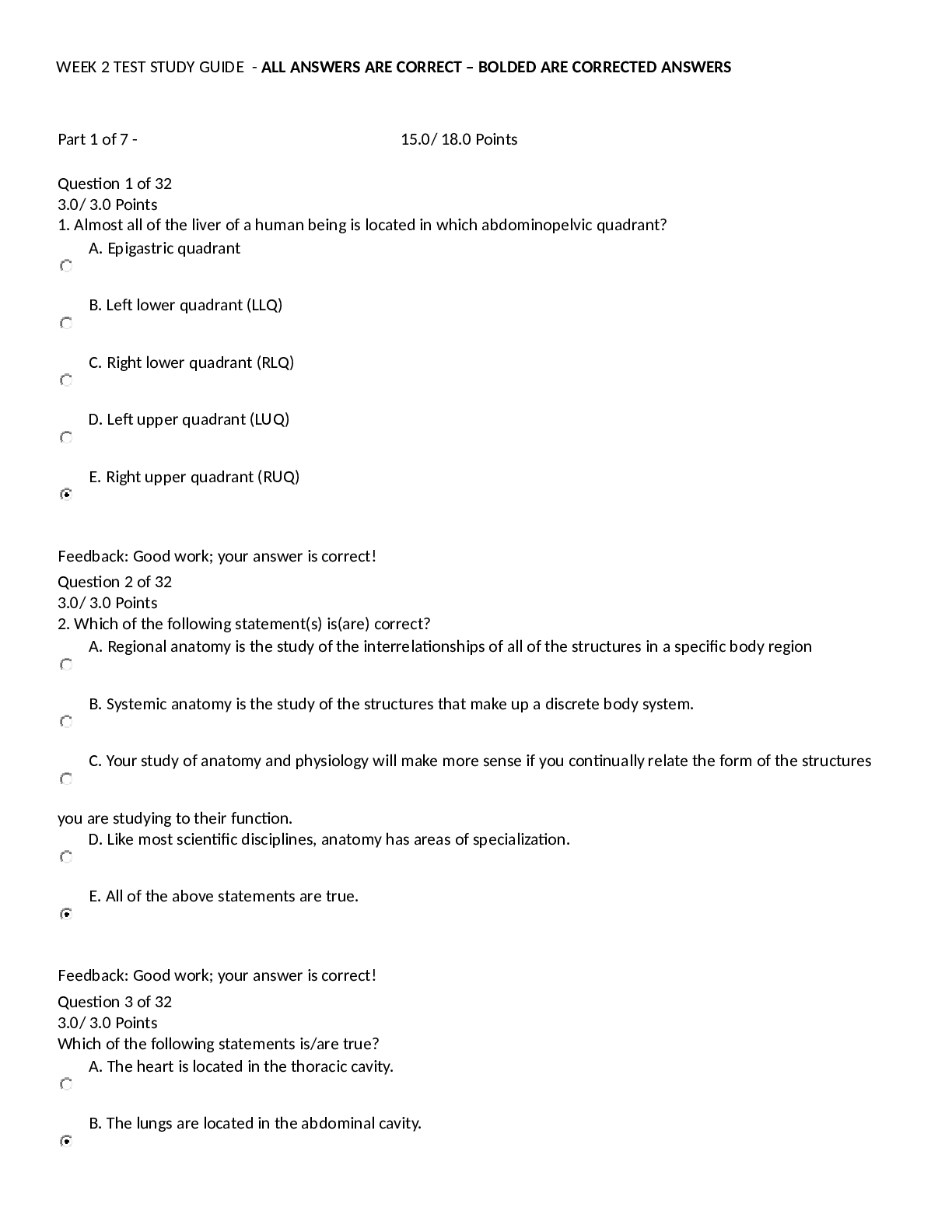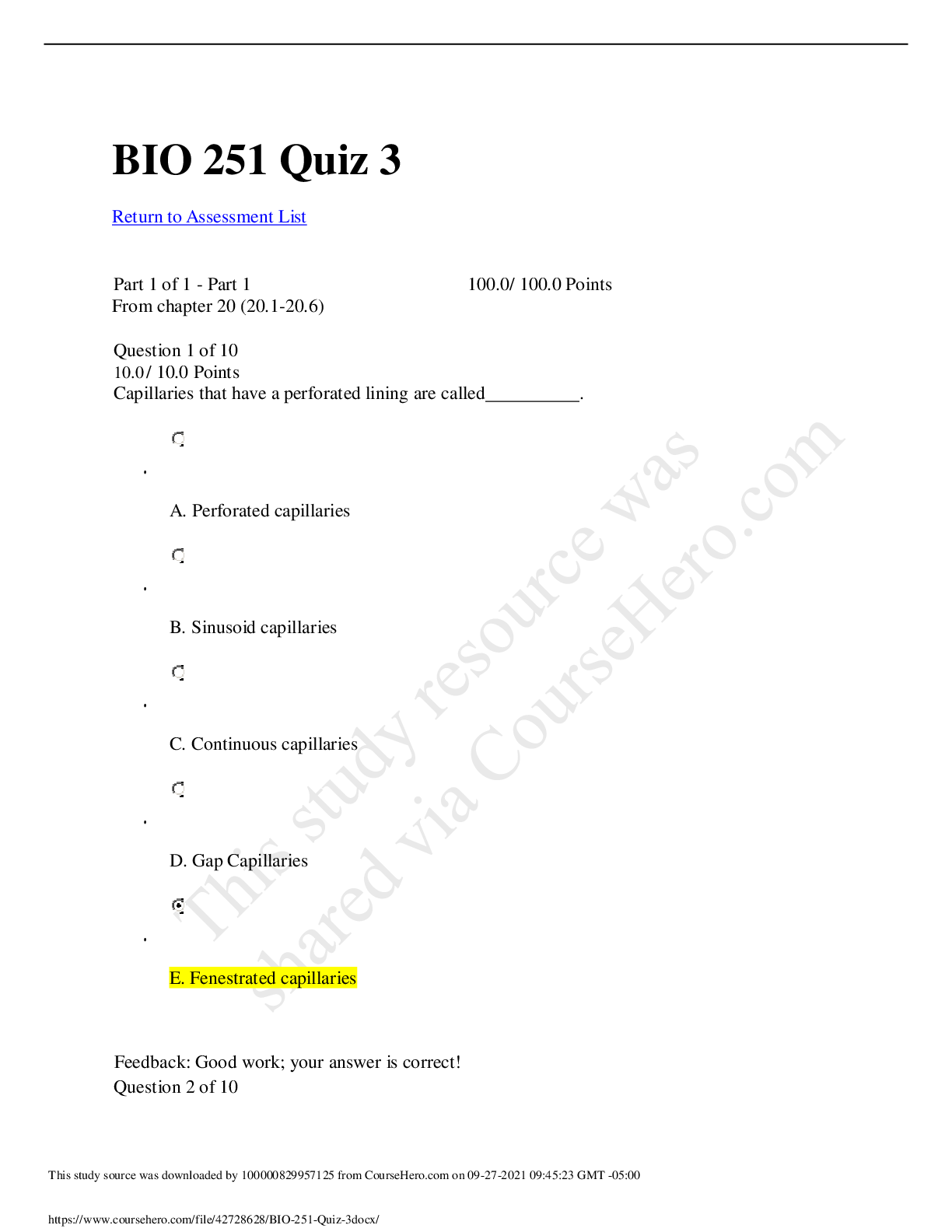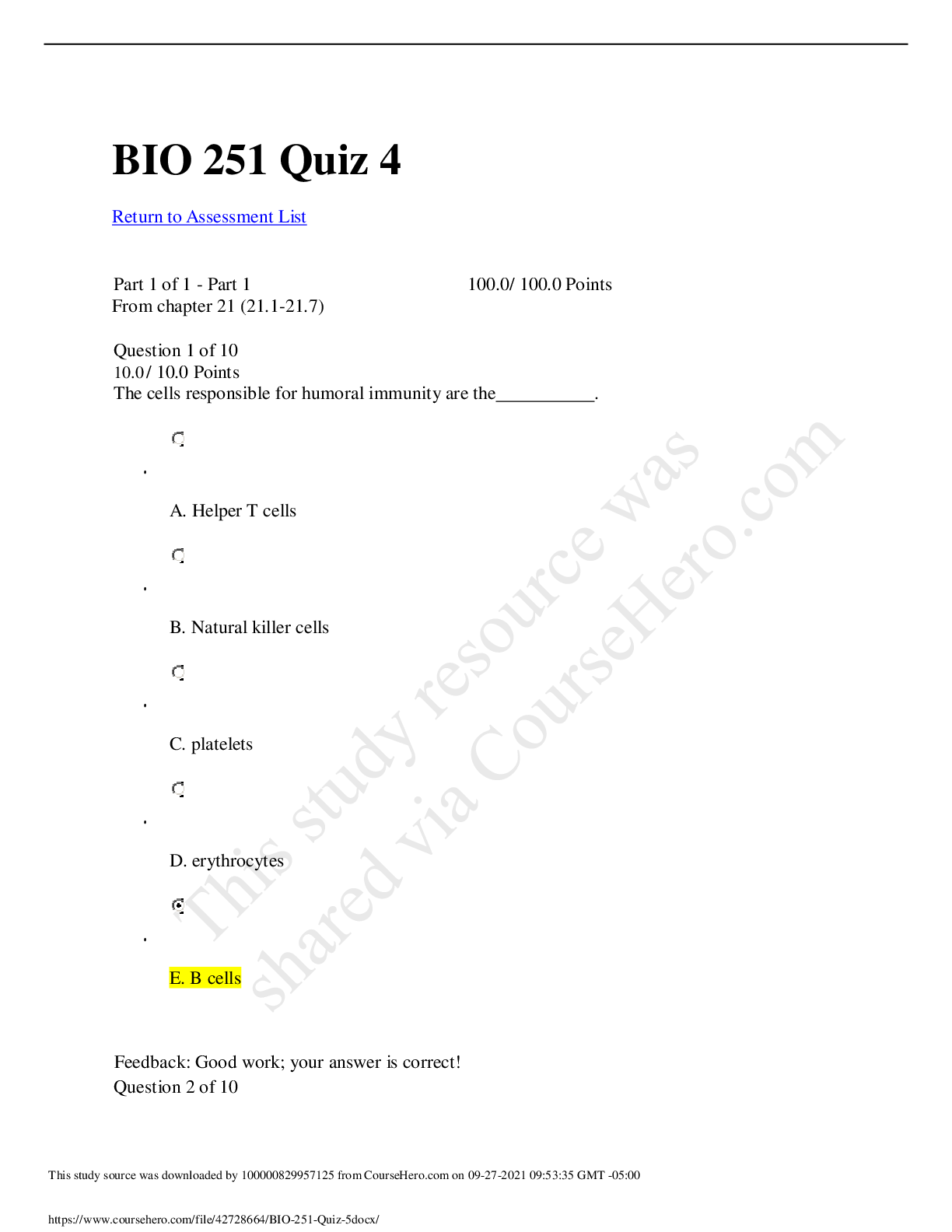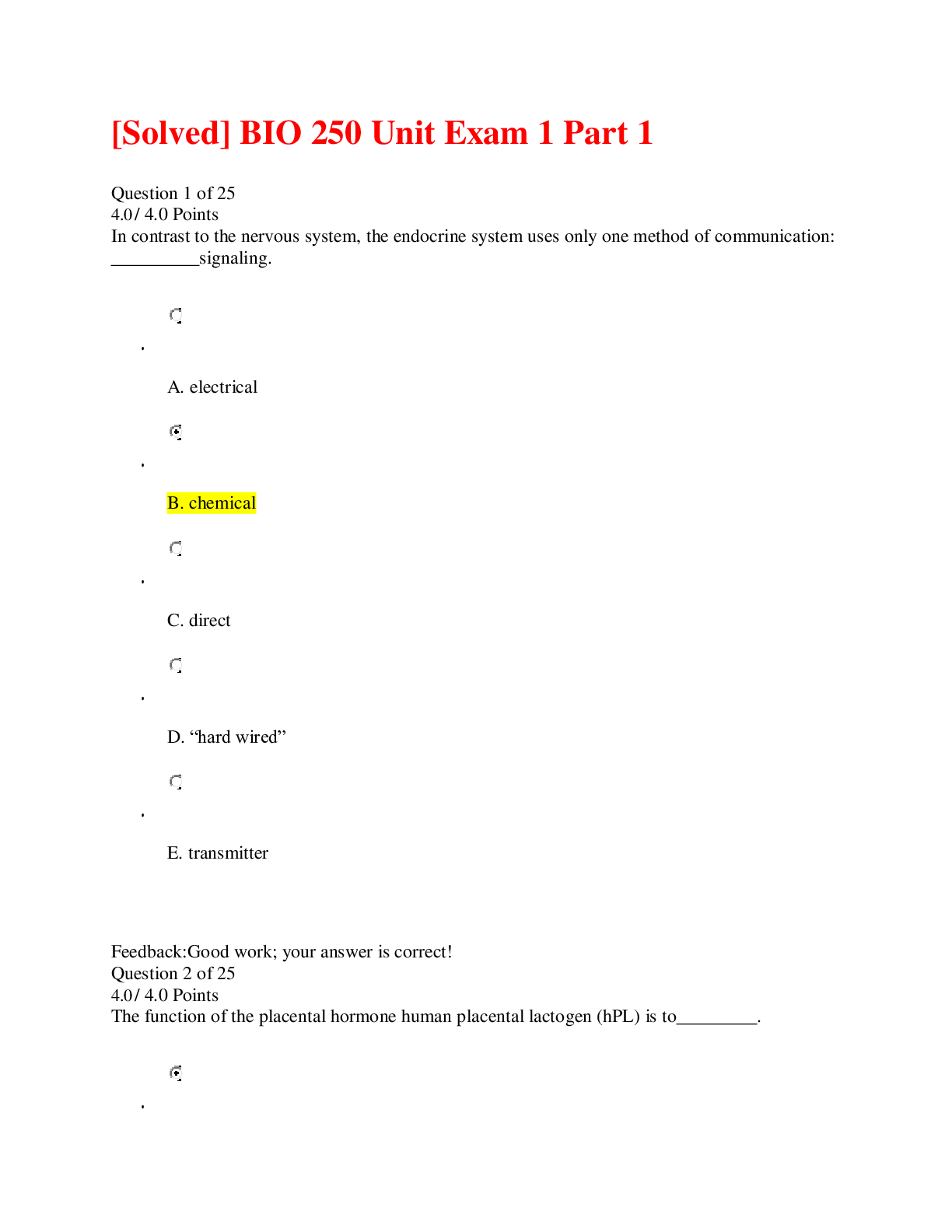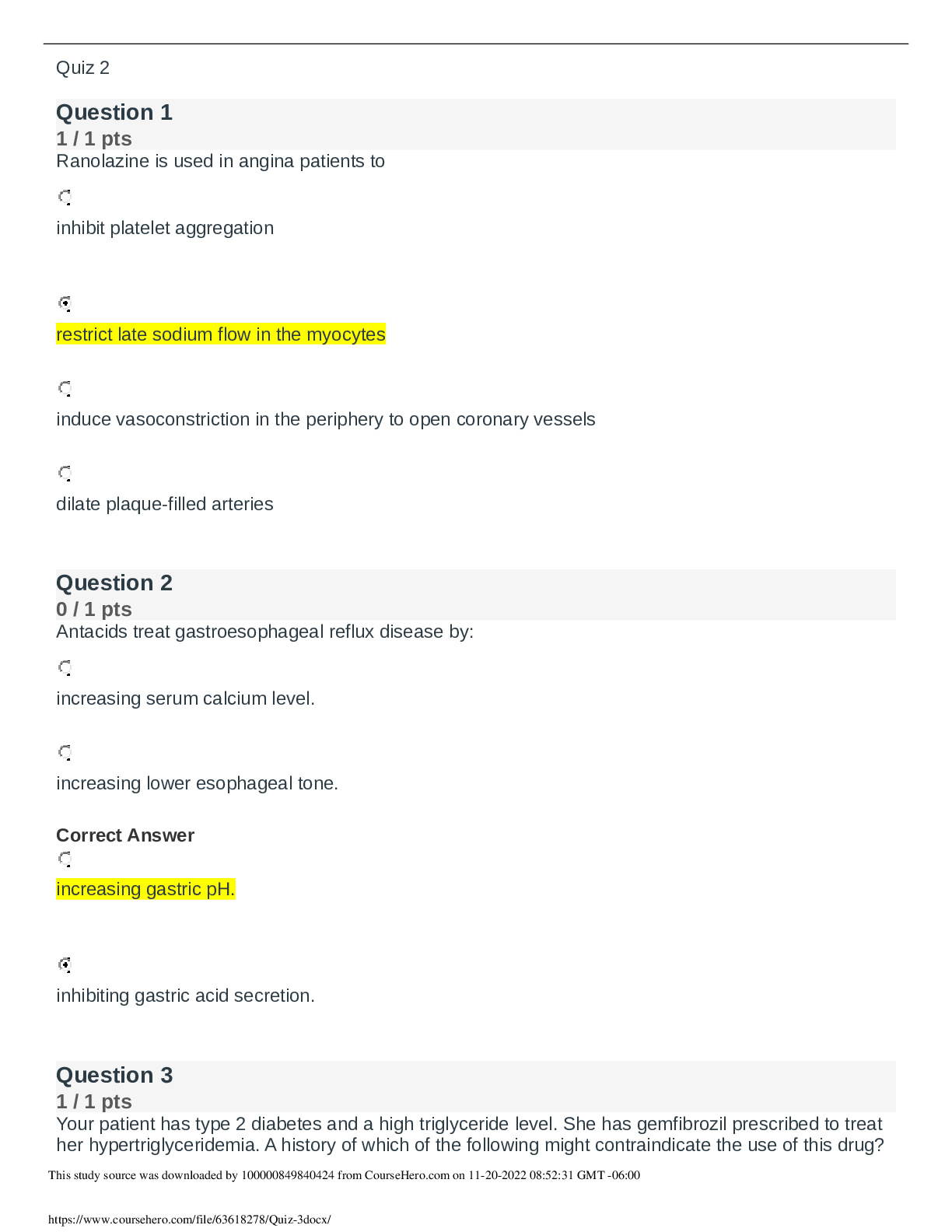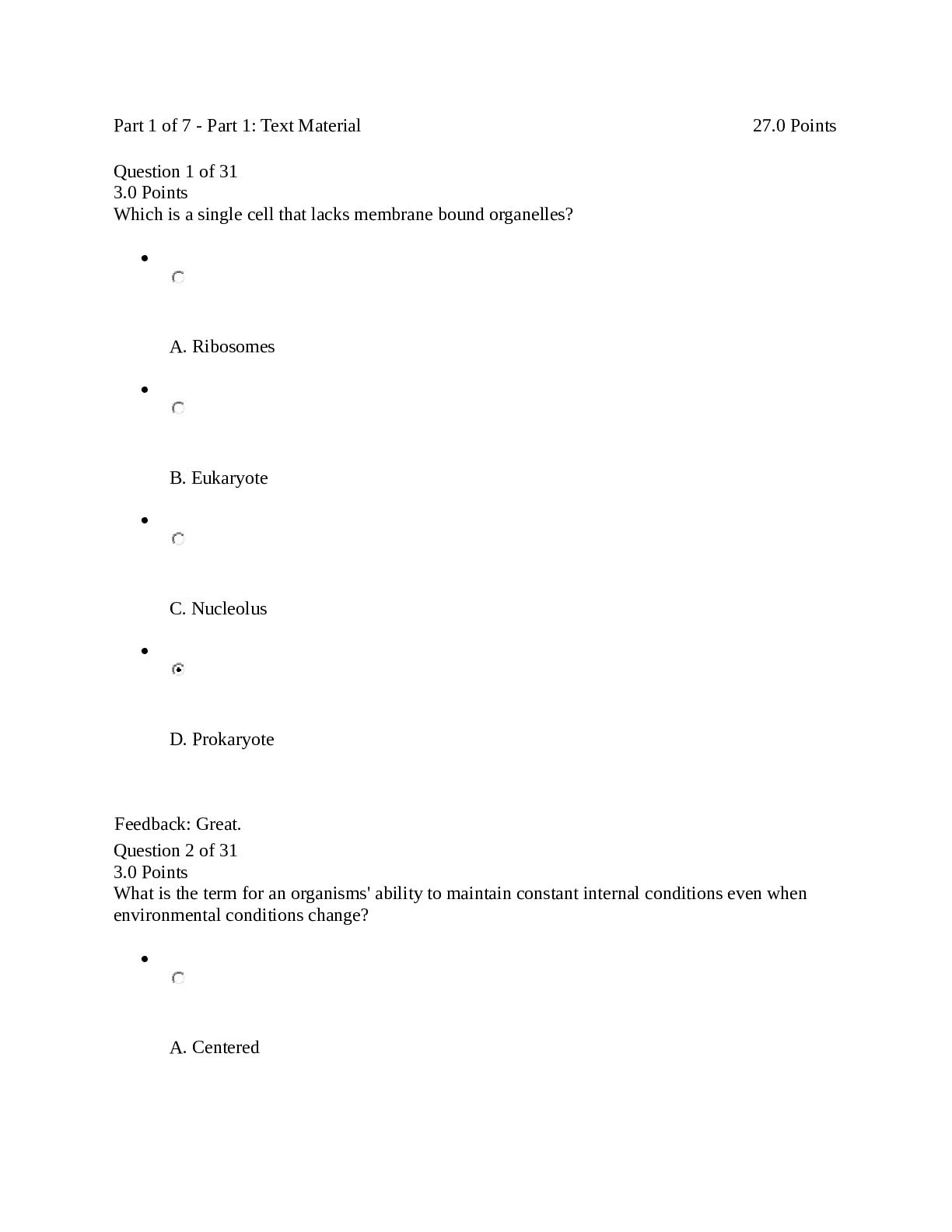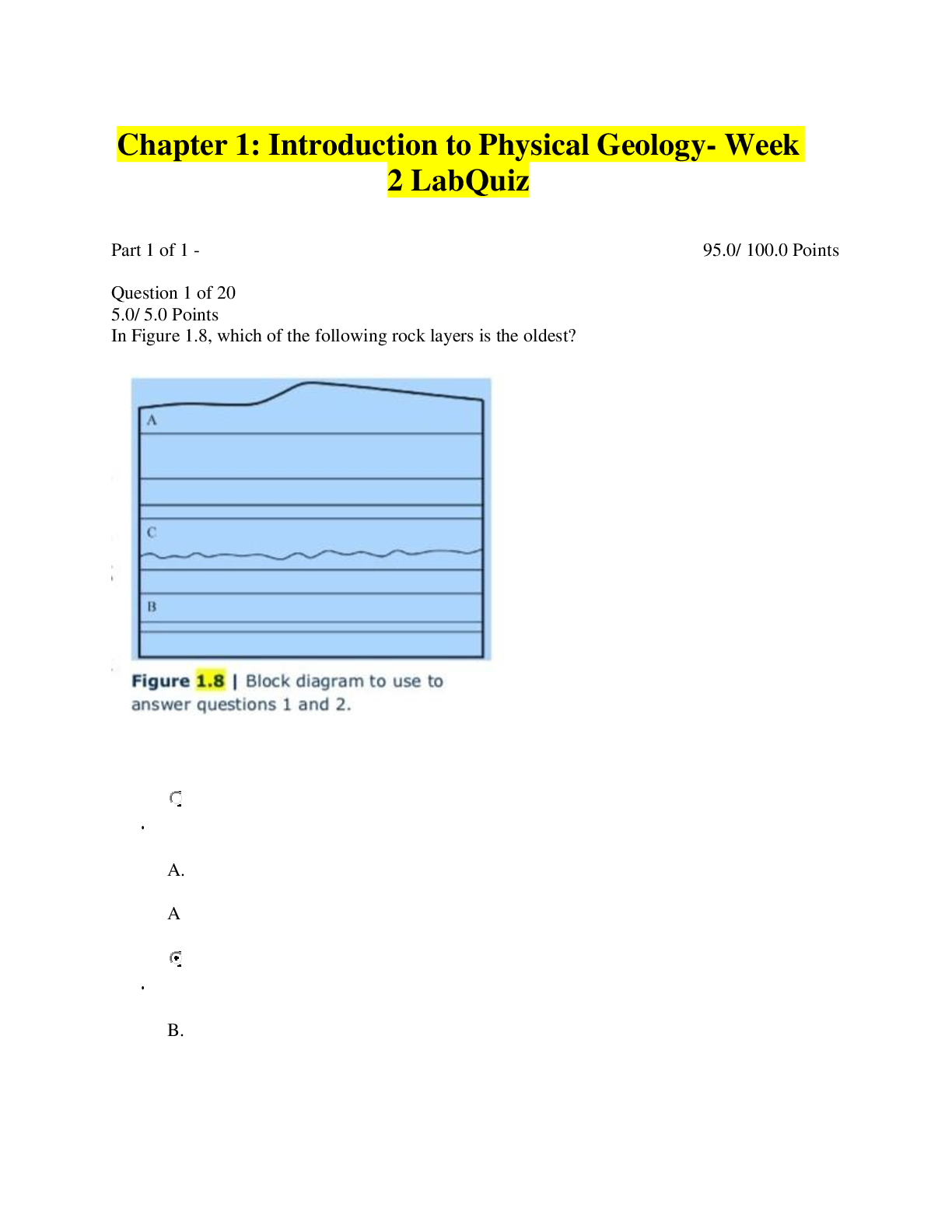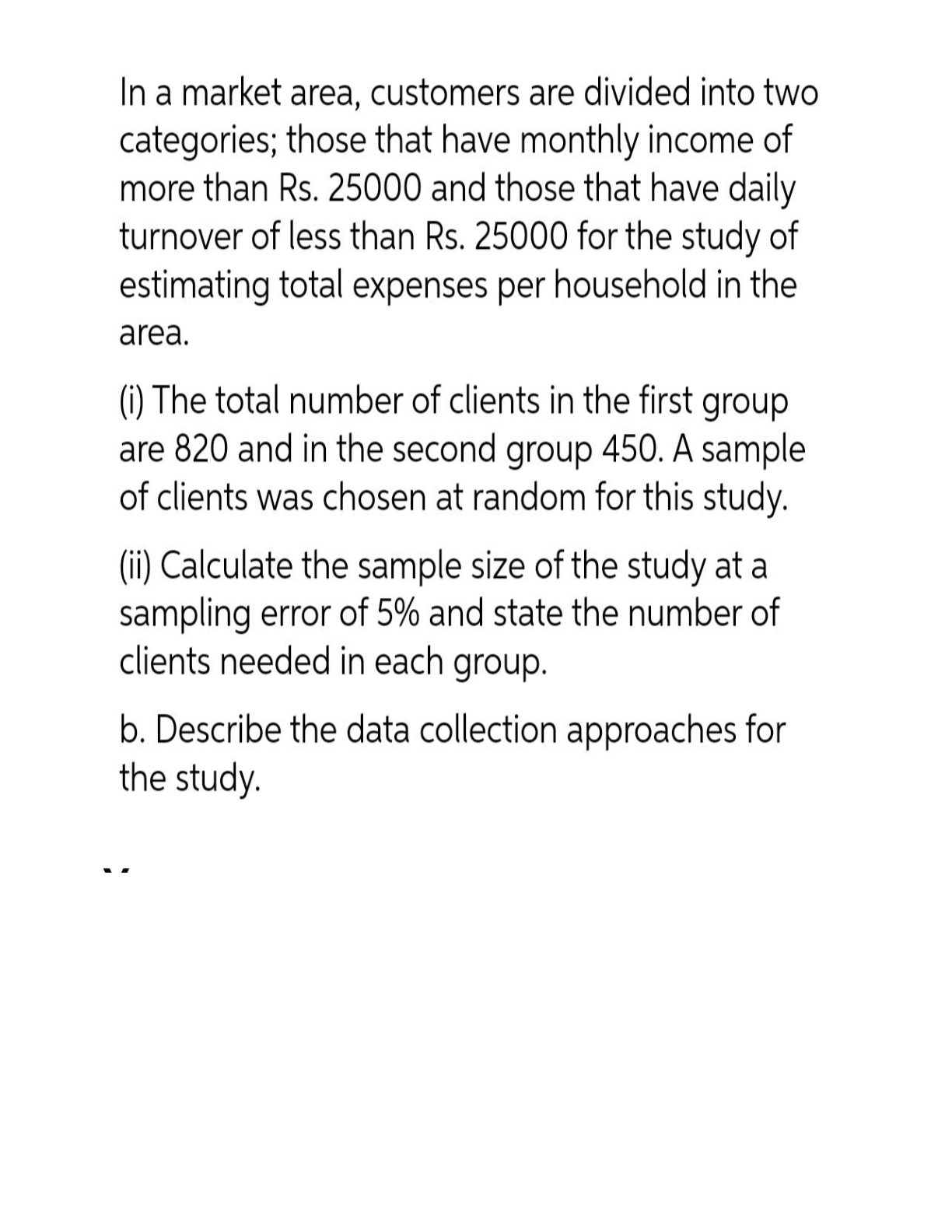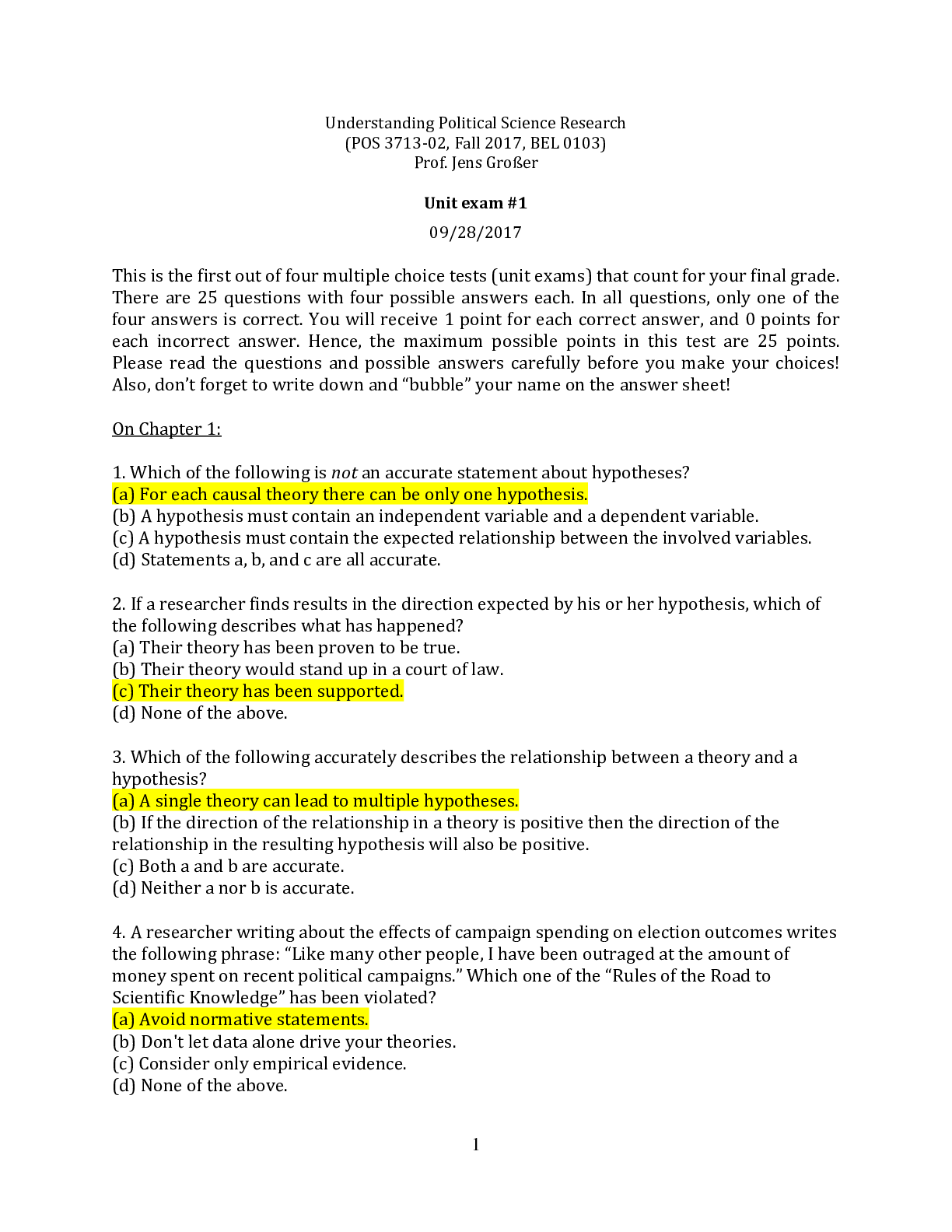Biology > EXAM > BIO 251 UNIT EXAM 1 Part 2 (GRADED A) /100% VERIFIED | American Military University (All)
BIO 251 UNIT EXAM 1 Part 2 (GRADED A) /100% VERIFIED | American Military University
Document Content and Description Below
BIO 251 UNIT EXAM 1 Part 2 Question 25 of 50 2.0 / 2.0 Points Which of the following is/are correct in describing thrombosis: • A. A condition characterized by excessive numbers of plat... elets that increases the risk for excessive clot formation, a condition known as thrombosis. • B. Thrombosis is a very common, always harmless condition that occurs in the body. • C. A thrombosis is always harmless because the thrombus which is formed always stays in a blood vessel precisely where it formed. • D. The blood stream contains several different anticoagulants that will result in the complete, normal breakdown of a thrombus. • E. Two of the above are correct. Feedback: Good work; your answer is correct! Question 26 of 50 2.0 / 2.0 Points The term formed elements in blood includes which of the following? A. albumin • B. plasma • C. hematocrit • D. white blood cells • E. All of the above are considered formed elements. Feedback: Good work; your answer is correct! Question 27 of 50 2.0 / 2.0 Points The most common blood type of all Americans is which of the following? • A. O- • • C. O+ • D. AB- • E. B+ Feedback: Good work; your answer is correct! Question 28 of 50 2.0 / 2.0 Points What is the typical lifespan of a leukocyte? • A. Many leukocytes can live indefinitely if they are in well-protected locations. • B. Because all leukocytes are unable to undergo mitosis (cell division), their lifespan is usually only a few seconds. • C. The lifespan of a leukocyte is extremely variable, measuring in hours to years or decades. D. The lifespan of a leukocyte is approximately 120-150 days. • E. The lifespan of a leukocyte typically is measured only in hours or days. Feedback: Good work; your answer is correct! Question 29 of 50 2.0 / 2.0 Points About 7% of plasma is made up of proteins. The most abundant of these plasma proteins is: • A. immunoglobulin • B. albumin • C. alpha globulins • D. fibrinogen • Feedback: Good work; your answer is correct! Question 30 of 50 2.0 / 2.0 Points What is meant by the term anemia? • A. Anemia is said to exist when the total white blood cell is too low. • B. Anemia exists when the platelet count is so low that blood does not clot as quickly as it should. • C. There are only approximately four or five causes of anemia. • D. Anemia always results from some very simple cause. • E. Anemia is defined as a deficiency in the number of red blood cells and/or hemoglobin. Feedback: Good work; your answer is correct! Part 3 of 3 - Part 3 32.0/ 40.0 Points From chapter 19 Question 31 of 50 2.0 / 2.0 Points Which of the following statements are considered to be normal? • A. Normal heart rates vary from 30 beats/minute up to 200 beats/minute. • B. A heart rate less than or equal to 60 beats/minute is called bradycardia. • C. A heart rate greater than or equal to 100 or 120 beats/minute is called tachycardia. • D. A person’s heart rate will change depending on the needs of the body. • E. B, C, and D are all correct. Feedback: Good work; your answer is correct! Question 32 of 50 2.0 / 2.0 Points In case of damage to the SA node, there are other sites in the heart which can depolarize and establish a rate of contraction of the cardiac muscle cells. For example: • A. The AV node itself can depolarize at rates of 40-60 times per minute. B. The cardiac muscle cells themselves can depolarize spontaneously at about 10 times per minute. • C. The bundle branches can each depolarize at rates of approximately 50-60 times per minute. • D. The Purkinje fibers can themselves depolarize at rates of about 5-10 times per minute. • E. Various other cells in either atrium can establish a heart rate of 100-140 beats per minute. Feedback: Good work; your answer is correct! Question 33 of 50 0.0 / 2.0 Points Which of the following statements about the left ventricle is/are true? • A. Blood entering the left ventricle is usually quite low in its oxygen concentration. • B. Blood exits the left ventricle through the aortic valve into the aorta. • C. The left ventricle contracts at the same time as the left atrium. • D. The wall of the left ventricle is very thin but also is very strong. • E. Both B and D are correct. Feedback: The left ventricle has a very thick and strong wall. It pumps highly oxygenated blood into the systemic circulation via the aortic valve. The right and left ventricles both contract at the same time. Question 34 of 50 2.0 / 2.0 Points By careful placement of surface electrodes on the body, it is possible to record the complex, compound electrical signal of the heart. This tracing of the electrical signal is the electrocardiogram (ECG). Which of the following statements is/are true? • A. A resting ECG usually takes approximately 1-2 hours to be recorded. • B. A normal ECG shows one single spike representing the contraction of the entire heart. • C. To record an ECG, 12-electrodes are placed in a circular pattern around the person’s chest. D. The ECG is useful for analyzing both normal and abnormal depolarizations of the heart. • E. These electrodes are placed using needles deeply in the skin of the chest. Feedback: Good work; your answer is correct! Question 35 of 50 2.0 / 2.0 Points Which of the following statements about the internal structure of the heart is/are correct? • A. The mitral valve is a bicuspid valve. • B. The mitral valve is located between the left atrium and the left ventricle. • C. The aortic valve is one of the semilunar valves. • D. The tricuspid valve is located between the vena cavae and the right atrium. • Feedback: Good work; your answer is correct! Question 36 of 50 2.0 / 2.0 Points What can cause the normal heart rate to increase or decrease? • A. The parasympathetic nervous system will cause the heart rate to increase. • B. The sympathetic nervous system will cause the heart rate to decrease. • C. The hormone named epinephrine will cause the heart rate to decrease. • D. Very few other chemicals or medications can cause the heart rate to either increase or decrease. • E. Nervous control over HR is centralized within the two paired cardiovascular centers of the medulla oblongata in the brain stem. Feedback: Good work; your answer is correct! Question 37 of 50 2.0 / 2.0 Points The QRS-complex of an ECG represents which of the following: A. The repolarizing of the ventricles. • B. The depolarizing of both atria. • C. The depolarization of the ventricles. • D. The repolarizing of both atria. • E. The depolarization as it travels through the AV node. Feedback: Good work; your answer is correct! Question 38 of 50 2.0 / 2.0 Points The specific fibers which spread the electrical impulse to the cardiac muscle fibers are called: • A. Purkinje fibers • • C. vagus nerve fibers • D. AV fibers • E. bundle branches Feedback: Good work; your answer is correct! Question 39 of 50 2.0 / 2.0 Points One of the most important ways of investigating the function of the heart is called the “cardiac output.” Which of the following facts is/are true? • A. Cardiac output, CO, is determined by multiplying the heart rate, HR, by the amount of blood that is pumped out of the left ventricle with each heart contraction, called “stroke volume” and designated as SV. • B. Is almost impossible to measure. • C. It cannot be measured without using very dangerous and invasive methods. D. The CO will never change in any one individual. • E. All of the above are true. Feedback: Good work; your answer is correct! Question 40 of 50 2.0 / 2.0 Points Which of the following statements about the circulatory system is/are correct? • A. The pulmonary circulatory system starts in the pulmonary trunk as the blood leaves the right ventricle and ends as the blood flows back into the left atrium. • B. The systemic circulatory system begins in the aorta as the blood leaves the left ventricle and ends as the blood returns to the right atrium. • C. The pulmonary arteries carry less oxygen than do the pulmonary veins. • D. The aorta is the largest blood vessel that exits from the heart. • E. All the above statements are true. Feedback: Good work; your answer is correct! Question 41 of 50 0.0 / 2.0 Points Which of the following statement(s) is (are) true? • A. The force the heart must overcome in order to pump blood is known as the its stroke volume. • B. The term preload refers to a tension, or pressure, that the left ventricle must develop in order for the heart to function properly. • C. The preload and afterload are the primary factors that cause the heart rate to change. • D. Contractility of the heart muscle refers to the force of contraction that this muscle can exert. • E. Both C and D are true. Feedback: Contractility refers to the force of the contraction of the heart muscle. Question 42 of 50 2.0 / 2.0 Points A pacemaker, which depolarizes spontaneously, establishes the rate of contraction of the heart muscle. The most common pacemaker of the heart • A. is called the AV node. • B. establishes a resting heart rate of about 60 to 80 contractions per minute. • C. functions also under the control of both the sympathetic and the parasympathetic nervous systems. • D. is located in the muscle of the left atrium. • E. Two of the above are true. Feedback: Good work; your answer is correct! Question 43 of 50 2.0/ 2.0 Points Which of the following statements is/are true? • • B. The size of a well-trained athlete’s heart is usually smaller than normal. • C. The size of the adult heart is about the same as the size of a newborn baby’s head. • D. The weight of the adult male and female hearts is approximately 1000 grams. • E. A typical heart is approximately the size of your fist: 12 cm (5 in) in length, 8 cm (3.5 in) wide, and 6 cm (2.5 in) in thickness. Feedback: Good work; your answer is correct! Question 44 of 50 2.0 / 2.0 Points The spontaneous action potential established in cardiac contractile cells is highly dependent on which of the following? • A. The sodium ion, Na+ • B. The potassium ion, K+ • C. The calcium ion, Ca2+ • D. Various voltage-gated ion channels • E. All of the above Feedback: Good work; your answer is correct! Question 45 of 50 2.0 / 2.0 Points The arteries that supply blood to the myocardium of the heart are called: • A. valvular arteries • B. pericardial arteries • C. myocardial arteries • • E. penetrating arteries Feedback: Good work; your answer is correct! Question 46 of 50 2.0 / 2.0 Points The period of time that begins with contraction of the atria and ends with ventricular relaxation is known as: • A. the cardiac cycle. • B. the P-wave. • C. an ECG. • D. diastole. • E. systole. Feedback: Good work; your answer is correct! Question 47 of 50 0.0 / 2.0 Points Which of the following statements about valves in the heart is/are true? • A. A valve enables blood to only flow in one direction. • B. A valve keeps blood from flowing in a reverse direction. • C. All of the valves open when the blood pressure on one side of the valve is higher than on the other side of the valve. • D. Statements A and B are correct. Statement C is incorrect. • E. Statements A, B, and C are correct. Feedback: Statements A, B, and C are correct. Question 48 of 50 2.0 / 2.0 Points Which of the following parts of an ECG represents the depolarization of the atria? • A. The T-wave B. The PR-interval • C. The QRS-complex • D. The ST interval • E. The P-wave Feedback: Good work; your answer is correct! Question 49 of 50 2.0 / 2.0 Points When a coronary artery is totally obstructed to any one portion of the heart muscle, what occurs? • A. A heart attack, or myocardial infarction, very likely occurs. • B. That muscle immediately spasms and then ruptures open. • C. That specific part of heart muscle immediately receives blood from a different artery. • D. All heart muscle immediately stops contracting. • E. The person usually feels no pain at all. Feedback: Good work; your answer is correct! Question 50 of 50 0.0 / 2.0 Points The opening of any heart valve only occurs when: • A. the cardiac muscle surrounding the valve contracts. • B. the chordae tendinae pull it open. • C. blood tries to flow in an incorrect/opposite direction. • D. papillary muscles push it open. E. the blood pressure in the heart chamber from which blood is flowing is higher than the blood pressure in the chamber to which the blood is supposed to flow. Feedback: The papillary muscles and chordae tendinae attached to a valve keep that valve from opening in an incorrect direction. When the valve is closed, the blood is not allowed to flow in an incorrect direction. Only a pressure difference will cause any valve to open. [Show More]
Last updated: 1 year ago
Preview 1 out of 22 pages
Instant download

Instant download
Reviews( 0 )
Document information
Connected school, study & course
About the document
Uploaded On
Sep 27, 2021
Number of pages
22
Written in
Additional information
This document has been written for:
Uploaded
Sep 27, 2021
Downloads
0
Views
85




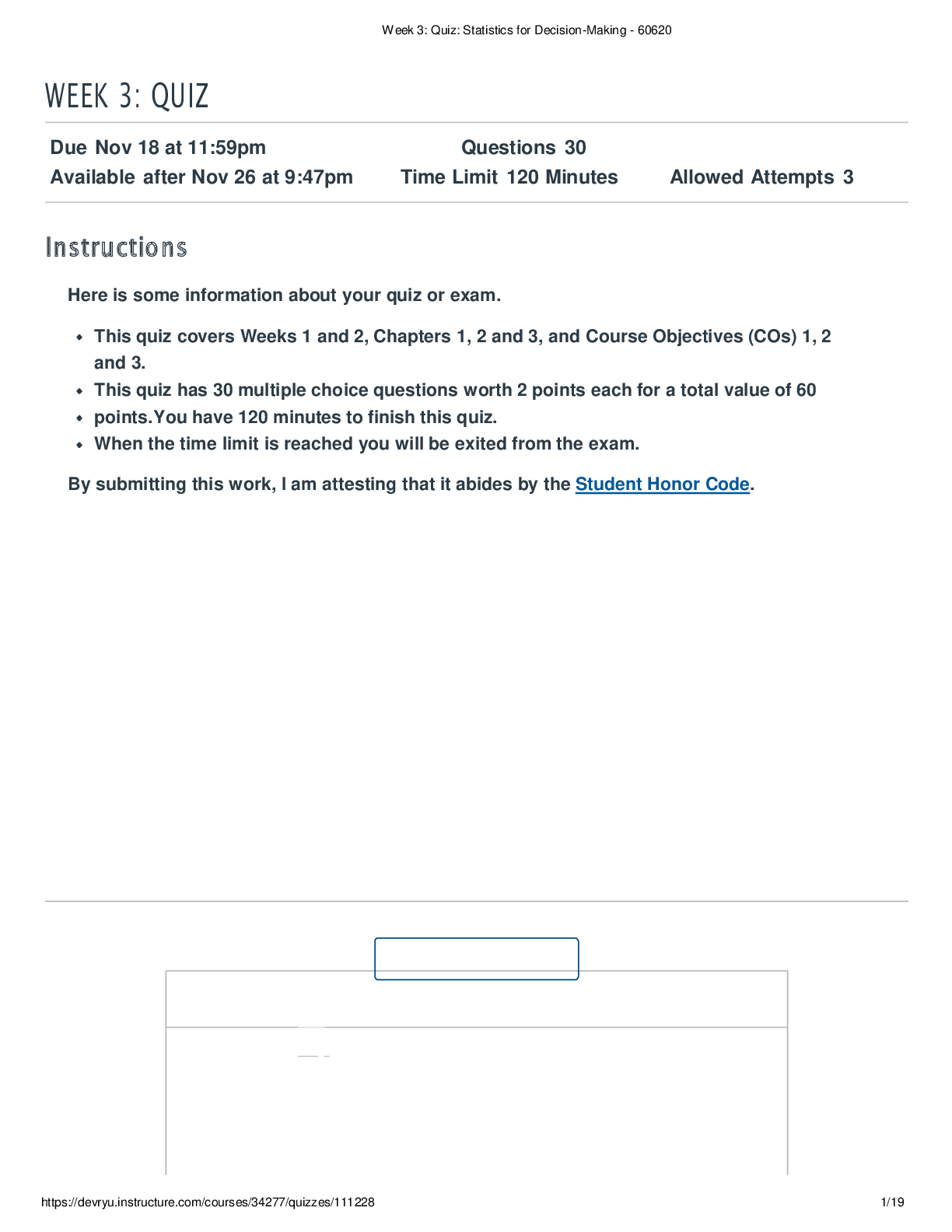

.png)










